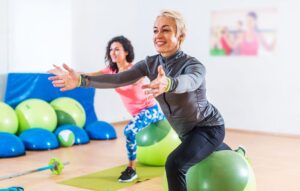
Stability training can help prevent injuries from occurring in the first place. It strengthens the muscles that support the joints and helps improve balance to reduce the risk of injury.
It also trains the smaller muscles that are often overlooked during standard exercises. These muscles are known as stabiliser muscles and are important for keeping the body in correct alignment during movement and resting positions.
Walking Lunges
Walking lunges are a great exercise to add to your leg day routine. They not only strengthen the lower body, but also improve balance and stability. This is because they require you to shift your weight and body position while standing on one leg, which challenges your ability to control the center of gravity.
While performing the exercise, Stabler says to avoid overextending your back knee by stepping forward until it’s parallel to the floor. This can lead to an injury in the hip joint, and it’s a common mistake people make while performing the exercise.
Another common mistake is rounding the spine while in a lunge, which can cause a back injury. Instead, keep the core engaged throughout the movement to prevent this from occurring. For an added challenge, add a single dumbbell or kettlebell in each hand to increase the load on your muscles and make the movement more challenging. Do 10 to 15 reps on each side for 2 to 3 sets.
Lateral Raise
The shoulder joint is a delicate piece of machinery. Bench and overhead press all you want, but without the right support from your rotator cuff and other supporting muscles, you could end up with boulder shoulders. Fortunately, the lateral raise is one of the best exercises to build a strong set of shoulders without overworking your joints.
The most common mistake people make with lateral raises is lifting their arms too high. This takes all the tension off your deltoids and shifts it to your traps, which defeats the purpose of this movement.
To avoid this, focus on form over load for this movement. Pick a weight that you can control for all of your sets and reps, and try to maintain the same form throughout each repetition. If you can’t, reduce the amount of weight you use. You can also switch to a seated dumbbell lateral raise, which limits the amount of momentum you need and allows for better range of motion on the movement.
Bent Over Row
This classic back movement helps prevent injury by targeting the muscles that support your posture. “If you don’t have strong posterior chain muscles your spine can take a beating,” says Orangetheory coach Rachel Skinner. “The best thing you can do is add a bent over row in your workout.”
Rows target the latissimus dorsi (the large wing-like muscles in your back), the middle and lower trapezius, the rhomboids and posterior deltoids. As a compound exercise, it activates the hip extensors as well.
When done correctly, the barbell row can be quite grueling as you’re pulling a heavy weight overhead. But it’s important to remember that rowing with a barbell is only one of many variations of the exercise that can be performed with dumbbells, kettlebells, or resistance bands. These movements also require more stabilization from assisting muscles than the barbell row. This is what makes them a better choice for beginner lifters or anyone looking to gain strength or muscle mass.
Single-Leg Deadlift
The single leg deadlift is a great exercise to include in a program that prioritizes the lower body and core. This movement is a safe way to add serious strength and muscle while also increasing balance and stability.
Like the lateral lunge, it trains the glutes and hamstring muscles. But it does this while challenging balance and hip stability. This is important because hip stability helps prevent the ball and socket joint of the hip from rattling around during walking and running.
This movement also targets the back extensors, which help shift the spine from a horizontal to an upright position. The erector spinae muscles — made up of the spinalis, longissimus, and iliocostalis — are all activated to prevent the spine from curving during the deadlift. This is why this exercise is important for injury prevention and performance. It prevents excessive flexion, which can lead to disc problems in the lumbar spine. It’s also a safer alternative to traditional deadlifts, which require significant shoulder and wrist support.